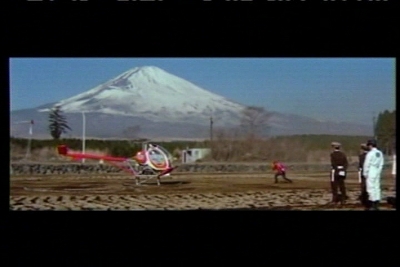 In the far flung future of…for all intents and purposes, 1967…the Fuji Astronautical Flight Center, Japan’s answer to Cape Canaveral, prepares a sixth manned mission to Mars. The previous five met mysterious ends at the hands of equally-mysterious UFOs supposedly camped out in interplanetary space. “Your job,” a FAFC flunky tells the doomed sixth crew of gullible space monkeys, “is to determine what’s stopping us from reaching Mars.”
In the far flung future of…for all intents and purposes, 1967…the Fuji Astronautical Flight Center, Japan’s answer to Cape Canaveral, prepares a sixth manned mission to Mars. The previous five met mysterious ends at the hands of equally-mysterious UFOs supposedly camped out in interplanetary space. “Your job,” a FAFC flunky tells the doomed sixth crew of gullible space monkeys, “is to determine what’s stopping us from reaching Mars.”
In the great tradition of Japanese sci-fi films from the sixties, the crew of the “nuclear powered ship” AB Gamma will fail miserably in this. However, by the time you reach the end of the film, you’ll have forgotten all about the UFO and the five crews of astronauts it allegedly obliterated. Rest assured the movie itself will have long since left such considerations dead in its wake. The X From Outer Space is a film obviously desperate to cash in on the daikaiju genre’s Silver Age, well underway at the time of its production. As the evil android, Ash, from Alien, said to his crew: “All other priorities are rescinded.”
We’ll spend a lion’s share of our time with the crew of the AB Gamma, so before we get to them, I’d like to talk about Shochiku, this film’s production company, who’d go on to give us Ghost in the Shell (written by Kazunori Ito, who also wrote the 1990s Gamera trilogy, beginning that same year with Guardian of the Universe…it’s all connected, you see). The X From Outer Space is both an answer and a homage to Godzilla, who became a single father in 1967, beginning his long, slow, decline. Ironic that Shochiku would need to latch on to some other studio’s kaiju coattails. Back in 1933, Shochiku may have produced a low budget knock-off of King Kong, featuring a man in an ape suit climbing over cities made of balsa wood. Prints of this film were either lost in the intervening years, or vaporized in the American firebombings of World War II. Shochiku, then, could be responsible for the first Japanese kaiju film ever. Was The X From Outer Space someone’s attempt to bring the crown back home? Was it writer/director Kazui Nihonmatsu’s?
Even if that’s the case, he picked a bad time. Over at Toho, Godzilla plugged alone just fine under director Jun Fukuda. Gamera continued to win partisans with his “friend-to-children-everywhere” bullshit. Shochiku really never had a chance. You’ll see.
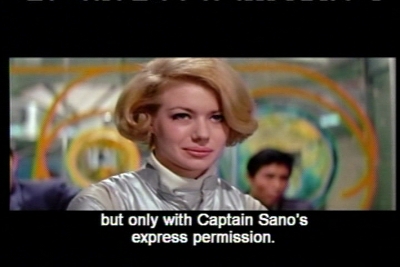 Captain Sano (Toshiya Wazaki) heads the crew with a commander’s stiffness, occasionally letting a playful side shine through, like Ah-nold in True Lies. Lisa (Peggy Neal), the “space biologist,” combats the passive sexism of the crew with a self-satisfied, crocodile’s smirk, letting us know that she knows she’s the smartest one in the room even while she serves coffee. Signal man Miyamoto (Shinichi Yanagisawa) provides the Odious Comic Relief, while Dr. Shioda (Keisuke Sonoi) we don’t really have to care about.
Captain Sano (Toshiya Wazaki) heads the crew with a commander’s stiffness, occasionally letting a playful side shine through, like Ah-nold in True Lies. Lisa (Peggy Neal), the “space biologist,” combats the passive sexism of the crew with a self-satisfied, crocodile’s smirk, letting us know that she knows she’s the smartest one in the room even while she serves coffee. Signal man Miyamoto (Shinichi Yanagisawa) provides the Odious Comic Relief, while Dr. Shioda (Keisuke Sonoi) we don’t really have to care about.
Soon after AB Gamma blasts-off (but not soon enough—here the film stops itself for the first of many mission control bull session between Token Anglo Dr. Berman (Franz Gruber) and the apparent head of FAFC, Dr. Kato (Eiji Okada)) our heroes find themselves beset by a flying saucer. Its unusual radiation scrambles com channels and apparently drives Dr. Shioda bonkers (cosmic—ha-ha—retribution for claiming, “I don’t think we need to worry” about the radiation). This necessitates an emergency landing at Moon Base MSC, after the UFO conveniently disappears. Guess that was just a drive-by. Damn you, alien gangbangers!
Turns out the Moon’s secretary is Captain Sano’s old squeeze, Michiko (Itoko Harada). “Did something happen between you two?” Lisa asks for all of us. Awkward, office-romance comedy ensues. Watch for the film’s Token Black Dude, a touch of color in a future of baggy jumpsuits, spinning radar dishes, space ships with fins, and moon bases from old If magazine covers, circa 1954.
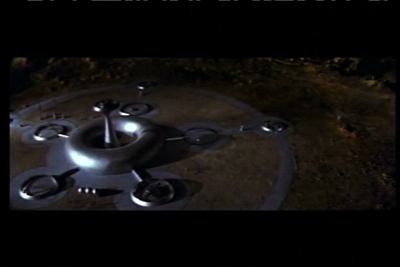 After a few drinks, the FAFC requisitions the moon’s doctor, Dr. Stein (Mike Daneen) the Other Token Anglo, to replace Shioda. Stein complains endlessly about his wife and about how he’s ‘sposed to be with her and blah, blah, blah. It’s all so unfair. Join a quasi-military organization and suddenly they expect you to follow these “orders”. What a total bitch, right?
After a few drinks, the FAFC requisitions the moon’s doctor, Dr. Stein (Mike Daneen) the Other Token Anglo, to replace Shioda. Stein complains endlessly about his wife and about how he’s ‘sposed to be with her and blah, blah, blah. It’s all so unfair. Join a quasi-military organization and suddenly they expect you to follow these “orders”. What a total bitch, right?
Back on course, Stein complaining so hard he even gets on the unflappable Captain Sano’s nerves. The most annoying character in the film, Stein nevertheless saves everyone when returning UFO locks the AB Gamma in a tractor beam. Stein foolishly wastes half the ship’s fuel, but he manages to escape. In a fit of pique, the UFO sprays Our Heroes’ engines with unidentifiable spores. (“A pox of tribbles upon your house!”) Like any good Space Biologist, Lisa collects one, doming unseen thousands of folks to a horrible death, thanks to Guilala.
Guilala is a monster, hatching out of that spore in true Blob-ian fashion just as soon as Michiko rescues the AB Gamma crew (in—what else?—a “rescue rocket”). They return to Earth rattled, but it’s nothing a party at Dr. Berman’s won’t cure. Time for drinking. At the least the Japanese astronauts are conscientious about not smoking in space. Planetside, it’s all about puffing and sipping and sexually harassing your female coworkers. Michiko, who accompanied the AB Gama crew to Earth (becoming fast friends, apparently, with Lisa) keeps things from becoming a complete sausage fest.
Guilala’s escape from the FAFC labs interrupts the gathering before anyone can even put their keys in the jar. And by now, X From Outer Space‘s real problem should be apparent to you. It follows King Kong‘s formula of back-loading its giant monster action, something as dangerous as front-loading the story with a half-assed love triangle-kinda-sorta-not-really thing. In space.
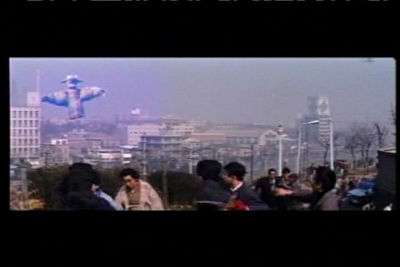 Not that the giant monster action isn’t wonderful. Guilala reaches full size (around 200 feet) quickly, and carves a wide swatch of HO-scale destruction across the countryside, handing the military its ass with the usual kaiju aplomb. But man-in-suit technology of the time was exactly one year away from reaching its pinnacle in Toho’s Destroy All Monsters . The limits of the form are already becoming apparent. What’s Guilala’s motivation for all this? He seems addicted to energy, via power lines or dams, or fuel…but is he, like Gamera, an ancient life form who just happens to able to turn himself into a giant, glowing ball and bounce around from place to place, wreaking things? Is he a war machine, sent by an alien intelligence to prepare us for conquest? What will that intelligence do once we neuter their toy? Why don’t they just nuke us?
Not that the giant monster action isn’t wonderful. Guilala reaches full size (around 200 feet) quickly, and carves a wide swatch of HO-scale destruction across the countryside, handing the military its ass with the usual kaiju aplomb. But man-in-suit technology of the time was exactly one year away from reaching its pinnacle in Toho’s Destroy All Monsters . The limits of the form are already becoming apparent. What’s Guilala’s motivation for all this? He seems addicted to energy, via power lines or dams, or fuel…but is he, like Gamera, an ancient life form who just happens to able to turn himself into a giant, glowing ball and bounce around from place to place, wreaking things? Is he a war machine, sent by an alien intelligence to prepare us for conquest? What will that intelligence do once we neuter their toy? Why don’t they just nuke us?
That humankind will triumph over the bad ol’ monster is assured. There’s a catchy optimism throughout all this, in spite of the human suffering a two hundred foot space chicken would cause. It’s a function of the character’s one-dimensionality. Only Lisa ends the film changed, and in the strangest of ways. Everyone else inhabits their roles without the slightest surprise. This is formula at its finest, and had X come out two, three, or five years earlier than it did, we would all remember it fondly. Instead, it slips into the lower echelon of the genre, a throwback, made before being a throwback was cool.
It’s not as if I hate the film. It’s problems are endemic to the genre form itself. Christ, some suit even says, “[Guilala] must not reach Tokyo.” This is a film swinging for the fences, too scared to do anything else. I wonder which of the three screenwriters—Moriyoshi Ishida, Eibi Motomochi, or the director—contributed all this monster material? Who put in the New Wave-y sci-fi bits, with the space program and moon base? Who pulled the character’s strings? And what’s that UFO? I kept expecting someone (Miyamoto, say, that fink) to say, “It looks like that fire-breathing turtle they shot into space last year.” Who’s driving that bus? What do they want? Why bring them up at all, when you’ve got a perfectly good space-chicken-loose-on-earth story without them? The ship could’ve picked up Guilala during its Obligatory Meteor Shower. They could just as easily have been the first mission to Mars as the fifth.
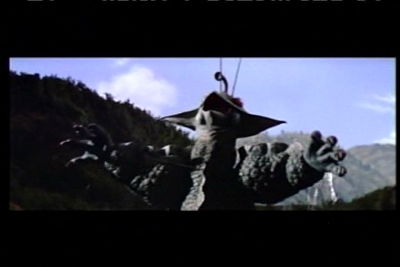 None of the actors are at fault, but it’s that old song: nothing to do, nowhere to go. Except into space and back. Gets monotonous after awhile. We thought the magic would go out of space exploration once it became commonplace. We never figured the magic to be directly proportional to moneyed interests and their ability to profit from our space race.
None of the actors are at fault, but it’s that old song: nothing to do, nowhere to go. Except into space and back. Gets monotonous after awhile. We thought the magic would go out of space exploration once it became commonplace. We never figured the magic to be directly proportional to moneyed interests and their ability to profit from our space race.
I’d only recommend The X From Outer Space to completists. Casual observers will break themselves upon the forty minutes of space romantedy. And one can ooh and ahh at the design of AB Gamma only do that so long before the static, stage-bound directing and children’s toy special effects sends you off to d-state. Once there, you might find yourself dreaming of a better film. Something with a stronger story, more evenly paced, allowing the actors to do something other than go up and down the cosmic treadmill.
The rest of you—you completists who haunt store shelves and troll through the series of tubes for films you maybe heard about only once, around the same time you discovered the joys of masturbation—you’ll find exactly what you’d expect. Plucky, can-do humanity once again defeats an alien-sponsored (?) giant monster rampage, utilizing a combination of stoic commander’s judgment (go go, Captain Sano) and good, ol’ fashioned Science. Cities crumble in their usual, antiseptic way, with none of the principal characters suffering more than a hangnail. Everyone (except for Lisa) lives happily ever after, and The X From Outer Space proudly marches back into the shadow lands of cult-obscurity, where it belongs.
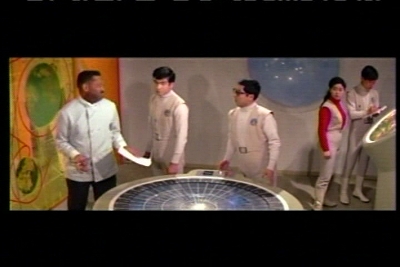
![]()
